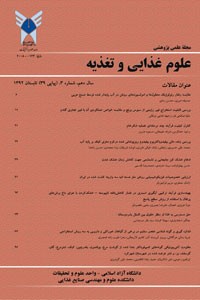بررسی اثر فیلمهای حاوی نانو ذرات نقره بر زمان ماندگاری رطب مضافتی
محورهای موضوعی : میکروبیولوژی مواد غذاییسیده فاطمه پیرو موسوی 1 , امیر حیدری نسب 2 , حسن هاشمی پور رفسنجانی 3 , علی اصغر رجبعلی پور چشمه گز 4
1 - دانشجوی کارشناسی ارشد دانشگاه آزاد اسلامی، واحد علوم و تحقیقات تهران، دانشکده فنی و مهندسی، گروه مهندسی شیمی، تهران، ایران
2 - دانشیار دانشگاه آزاد اسلامی، واحد علوم و تحقیقات تهران، دانشکده فنی و مهندسی، گروه مهندسی شیمی، تهران، ایران
3 - دانشیار دانشگاه شهید باهنر کرمان، دانشکده فنی و مهندسی، گروه مهندسی شیمی، کرمان، ایران
4 - مربی بخش تحقیقات فنی و مهندسی، مرکز تحقیقات جهاد کشاورزی و منابع طبیعی کرمان، ایران
کلید واژه: رطب مضافتی, زمان ماندگاری, نانو ذرات, نانو ذرات نقره,
چکیده مقاله :
مقدمه: هدف از این مطالعه بکارگیری فیلم های پلیمری حاوی نانوذرات نقره به عنوان روشی جدید، برای افزایش زمان ماندگاری و حفظ کیفیت در محصول تجاری-صادراتی استان کرمان و همچنین تعیین دمای مطلوب برای نگهداری این محصول می باشد. مواد و روشها: در این تحقیق بعد از تهیه فیلم های نانوکامپوزیتی حاوی نانوپودر نقره (3% و 5% ) رطب مضافتی عزیزاباد بم درون پوششها بستهبندی شده و همراه نمونههای شاهدشان در چهار دمای˚C 50 ، ˚C20 ،˚C 8 و˚C4 ذخیره شدند. این نمونهها 2،7،21 و 53 روز پس از ذخیره سازی تحت آزمایشات تایید شده توسط موسسه تحقیقات استاندارد صنعتی ایران برای خرما که شامل آزمایشات pH، TSS، اسیدیته و قند احیاء می باشد، قرار گرفتند. یافتهها: به طور کلی همان طور که انتظار می رفت با افزایش اسیدیته، مقدار pH در هر دو نمونه 3% و 5% و شاهد کاهش یافت همچنین مقدار اسیدیته در نمونههای 5% نسبت به نمونههای 3% و شاهد تقریبا در تمامی تیمارها کمتر بود و مقدار pH برای این نمونهها تقریبا مقدار بیشتری از نمونههای 3% و شاهد داشت. با بررسی اعداد بدست آمده از ازمایشات قند احیاء، مشخص شد که مقادیر قند احیاء مربوط به نمونه های شاهد از مقادیر مربوط به نمونههای 3% و 5% کمتربود. مقدار TSS نیز که مربوط به میزان رسیده بودن نمونه هاست در نمونههای مختلف مقادیر متفاوتی داشت. نتیجهگیری: بیشترین زمان ماندگاری مربوط بهنمونههای بسته بندی شده در پوششهای حاوی 5% نانوپودر نقره به مدت 53 روز و بهترین دما برای نگهداری نمونه ها دمای ˚C4 تعیین شد.
Introduction: The aim of this study is to increase the shelf life and improve the quality of the product trade and export in Kerman Province by using coatings containing nanosilver particles and determining the optimal temperature for the storage of this product. Materials and Methods: In this study, nanocomposite LDPE films containing nanosilver particles were prepared (3%, 5%), Dates from Aziz Abad, Bam were packed in nano-coated coverage and were stored at 50, 20, 8 and 4 UC. The samples were examined after 2, 7, 21 and 53 days. The experiments concerned with pH, TSS, acidity and reducing sugar were carried out according to the approved methods by the Research and Industry Standard Institute of Iran.Results: By increasing the acidity, the pH values decreased for all the samples examined including the control. The acidity for the samples containing 5% nanosilver particles was less than the samples containing 3% nanosilver particles and the control. The control sample showed lower concentration of the reducing sugar as compared to the samples containing 5 and 3% nanosilver particles while TSS values that are related to the ripening of the samples were different for all the samples examined.Conclusion: The samples packed with 5% nanosilver particles and kept for 53 days at 4UC showed better quality as compared to other samples.
Appendini, P., & Hotchkiss, J. H. (2002). Review of antimicrobial food packaging. Innovative Food Science & Emerging Technologies, 3, 113-126.
Barreveld, W. H.(1994). Date palm products. FAO Agricultural Services Bulletin, 216 PP.
Chaudhry, Q., Scotte, M., Blackburn, J., Ross, B., Boxall, A., & Castle, L. (2008). Applications and implications of nanotechnologies for the food sector. Food Additives and Contaminants, 25(3), 241–258.
Emamifar, A., Kadivar, M., Shahedi, M. & Soleimanianzadeh, S. (2010). Effects of nanocomposite packaging containing silver and zinc oxide on the shelf-life of fresh orange juice, Innovative Food Science and Emerging Technologies742-748.
Fernández, A., Soriano, E., López-Carballo, G., Picouet, P., Lloret, E. & Gavara, R. (2009). Preservation of aseptic conditions in absorbent pads by using silver nanotechnology. Food Res Int; 42:1105-12.
Han, J. H. & Rooney, M. L. (2002). personal communications. Active Food Kubacka A, Cerrada ML, Serrano C, Fernández-García M, Ferre M, Fernández-García M. Plasmonic nanoparticle/polymer nanocomposites with enhanced photocatalytic antimicrobial properties. J Phys Chem; 2009; 113: 9182–90
Packaging Workshop, (2002). Annual Conference of the Canadian Institute of Food Science and Technology (CIFST), May 26,.
Raija, A. (2003). Novel food packaging Techniques, First published, Woodhead Publishing Limited and CRC Press LLCß, Woodhead Publishing Limited,Woodhead publishing in food Science &Technology.
Dastjerdi, R. & Montazer, M. (2010). Textile Engineering Department, Center of Excellence in Textile, Amirkabir University of Technology (Tehran Polytechnic), Hafez Avenue, Tehran, Iran, Colloids and Surfaces B: Biointerfaces 79 .5–18
Quintavalla, S. & Vicini, L. (2002). Experimental Station for the Food Preserving Industry, V.le Tanara, 31/A, 43100 Parma, Italy, Meat Science 62 373–380.


